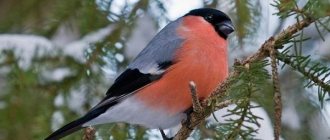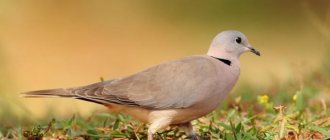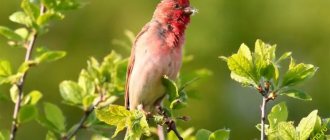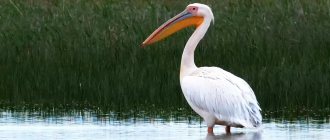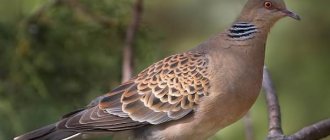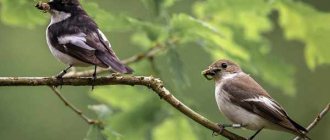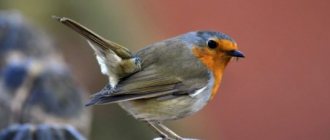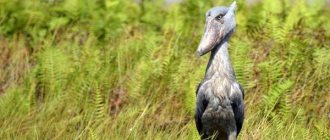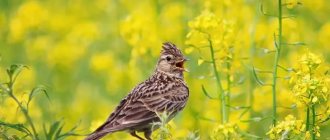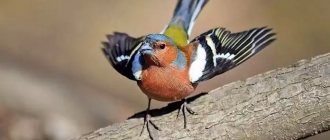The bullfinch proudly bears the title of “winter bird”: this bright-breasted mysterious person appears with the arrival of cold weather and disappears along with the first greenery on the trees. But is it? Today in the article we will talk about the bullfinch, its appearance and habitats, nutrition and life expectancy, reproduction and raising of offspring. We will also tell you how to keep and breed bullfinches at home, share interesting facts about these birds, and maybe even dispel some myths.
Photo of the common bullfinch on a branch in winter
Description of the bird
Small songbirds from the finch family - bullfinches - are called Pyrrhula in Latin, which translates as “fiery”, and indicates the bright special color of their plumage.
The genus includes 9 species and is divided into two subgroups: masked and black-capped bullfinches. In masked birds, black feathers around the beak create a kind of “mask”; in black-capped birds, it is on the back of the head.
— Advertising —
The size of these birds is small - up to 15 cm in length, with a wingspan of up to 25 cm and a weight of about 35 g.
general characteristics
Scientists classify bullfinches as members of the finch family. It is one of the most numerous and diverse songbirds belonging to the passerine order. Their name is translated from Latin as “fiery,” symbolizing the unusual color of their plumage.
Bright bullfinch breast
Bullfinches are small in size. Their weight is about 30-35 grams, but the body itself is dense and strong. The body size is about 17 cm, and the wingspan in flight reaches 25-30 cm.
With the advent of cold weather, it seems that bullfinches become larger than they are. This is due to the bristling plumage, which is necessary to retain heat.
The color of bullfinches is distributed in such a way that the separation of colors depending on the parts of the body is clearly visible on the body. Usually there are no blotches or spots in the feathers. The lower part directly depends on the type and individual characteristics of the bird. The flight feathers are usually black with a blue tint. The areas under and above the tail are painted white.
Bullfinches have a strong beak, which allows them to easily crush berries and seeds, which makes it possible to obtain food for themselves.
A characteristic feature of birds is considered to be pronounced sexual differences, manifested in color. The most visible part, the chest, in males has bright red feathers, in females it is much less prominent. Their feathers are usually pinkish-gray in color.
Sexual dimorphism in birds
What does it eat?
The bullfinch eats frozen berries.
The bullfinch is unpretentious in nutrition. Its main food consists of seeds and berries, from which birds eat them, leaving pulp, as well as insects. If you ask yourself what do bullfinches like or what do they feast on, the answer is: the color of oak trees, willow catkins, dandelions, nettles, blackberries, sorrel. In addition, in winter the bullfinch eats rowan berries, which is an unforgettable sight.
Young bullfinches are also fed plant foods, to which insects and spiders are added.
Nutrition
This bird, like all finches, feeds mainly on food of plant origin - hence its tendency to settle in forests. During the period of feeding the chicks, however, the bullfinch is forced to diversify its diet not only with seeds, berries and buds, but also with small insects, most often spiders.
While feasting on berries (in particular, rowan, hawthorn), the bullfinch does not eat the pulp, pecking only the seed itself. The bird is helped in this by a short beak with sharp edges, almost as strong as that of a parrot.
Only all kinds of seeds are the favorite delicacy of bullfinches; this was probably noticed by those who tried to feed them with crumbled bread in winter.
Where does it live?
— Advertising —
Pyrrhula pyrrhula range
Bullfinches live in coniferous forests, forest-steppe and forest-tundra throughout Eurasia. They inhabit both lowland and mountainous areas, but like to settle in forests. Bullfinches are not afraid of people, so they can often be found in gardens and parks. In addition, deforestation and destruction of their natural habitat contributes to the relocation of bullfinches closer to humans.
Where do they live in the summer?
Photo of a bullfinch, in summer
Bullfinches live in coniferous highland and lowland forests in summer, avoiding treeless areas. On the territory of Russia, the bird lives in the forest and forest-steppe zones. In summer, birds hide in the crowns of trees and feed on coniferous tree buds, berries, and seeds.
Is the bullfinch a migratory bird or not?
In nature there are resident and migratory birds. It is known that migratory birds try to fly to warmer regions for the winter. But people often wonder whether bullfinches fly in the summer?
Much is known about the life of bullfinches in winter:
- Their flock consists of 7–10 individuals.
- The colder it is, the less mobile they are.
- When it starts to get dark outside, these birds begin to look for branches or bushes for the night.
- In the first half of the winter period, their whistle is heard rarely, and in the second half - more often.
But already in mid-April these birds disappear, and no one sees them until cold weather sets in. But where do they go? Are bullfinches migratory or sedentary birds? Bullfinches fly in winter. They can settle to the south: to the Amur basin, Central Asia, Transbaikalia, Crimea and North Africa. But already at the end of March or at the beginning of April they return, but hide from people for the summer .
Bullfinches are sedentary birds that try to hide further into the thicket of the forest during the summer. They can also fly away from cities to places where they will find silence and solitude. In summer, they build their nests on the highest branches inaccessible to humans. There is enough food at this time, so there is no need for people.
Kinds
Common bullfinch
This is what a male bullfinch looks like.
This bird is the size of a sparrow. The plumage on the crown, around the eyes and beak is black. The wings are also black with a blue sheen. The back is gray with a whitish loin. And the belly, sides, cheeks and chest in males are intense red, in females they are grayish-brown. The chicks are colored in various shades of brown and do not have a black cap of feathers on their heads.
The habitat is very wide - Europe, Central and East Asia, including Japan, Kamchatka and Siberia.
Azores bullfinch
In the photo, the Azores bullfinch is sitting on a branch.
It lives only on the island of Sao Miguel (Azores) and is an endangered species. The plumage of the Azorean bullfinch is chocolate brown, with red spots on the sides. In summer the color becomes lighter. On the bird's head, black feathers form a “cap”; the chin and beak are also black. The chest and belly are brown. The species is larger in size than the common bullfinch (up to 17 cm in length). There is no sexual dimorphism.
White-cheeked bullfinch
White-cheeked Bullfinch eats a tree bud
An inhabitant of the high-mountain coniferous forests of the Philippine archipelago and the southernmost tropical species of Black-capped Bullfinches. The plumage is mostly brown with pure white cheeks and white patches on the sides. Females and males are no different.
Brown bullfinch
Photo of a brown bullfinch on a branch.
It belongs to the group of masked bullfinches and lives in the mountain coniferous forests of Indochina, South Asia, and Taiwan.
The plumage is very similar to an ordinary bullfinch with only one difference - the tummy, chest and cheeks of the brown bullfinch are brown. That is why females and males of this species are practically indistinguishable from each other.
Yellow-backed Bullfinch
Yellow-backed bullfinch - photo
It is found in the forests of the Western Himalayas (India and Pakistan) in a very limited area, which is why it is considered an endangered species.
The yellow-backed bullfinch is a small masked bullfinch with a predominant orange-ochre tinge in its plumage. Males are brighter than females, especially in the dorsal and crown areas. Females are gray-brown in color.
Red-headed Bullfinch
Red-headed Bullfinch on a branch
This species is a small, colorful masked inhabitant of the Himalayas. Its size is slightly smaller than a sparrow. The wings are black with a red spot, the back is gray. The head, chest and abdomen of the male are orange-red; in females they are yellow.
Grey-headed Bullfinch
The gray-headed bullfinch feeds.
It belongs to the group of masked bullfinches. The plumage is predominantly gray with a bright orange belly, decorated with red spots in males. Females are modest - with a gray-brown chest and abdomen.
The grey-headed bullfinch is widely distributed from the Western Himalayas to the north and east of China.
Gray bullfinch
Gray bullfinch photo in winter
An inhabitant of Siberia and the Far East, the plumage of which lacks red. Dimensions: slightly smaller than the common bullfinch. The plumage on the top of the head, around the beak and eyes is black. The wings are black with a blue metallic sheen. The loin and undertail area are painted white.
Ussuri bullfinch
Ussuri bullfinch in eastern Russia
One of the smallest bullfinches, lives in the Far East, Sakhalin, the Japanese and Kuril Islands. The species belongs to the black-capped bullfinches. The cheeks and throat of the male are intensely colored red-orange. The abdomen is gray with a pink tint. The female is lighter than the male, with a predominance of brown shades in the plumage.
Reproduction and offspring
Bullfinches return to their usual habitats with the onset of spring, but already at the end of winter the males make attempts to gain the sympathy of the females. The closer and more clearly the warmth is felt, the more persistent the males become. During this period, the first pairs begin to form, after which bullfinches begin building nests. Birds place them on thick spruce branches, away from the tree trunk, as well as on birches, pine trees, and tall juniper bushes.
Already in May, clutches of eggs can be found in nests, and in June, the offspring that are born learn to fly. The bullfinch's nest in appearance resembles something like a bowl, which is woven from spruce branches and other building material. Each clutch consists of an average of 5 eggs, about 2 cm in size, light blue in color, covered on top with brown spots located randomly.
Interesting to know! The female incubates the eggs for 2 weeks. The male begins to take care of his offspring when the chicks begin to learn to fly. The fact that each family of bullfinches has 5 chicks on average is considered normal.
Parents feed their offspring until the chicks learn to get food for themselves. Starting in July, the juveniles gather in flocks, and already in September/October they fly out of the dense thickets. At the same time, they join flocks that move to warmer regions before the onset of winter.
What does a male and female look like?
Differences between female and male bullfinch - visual drawing
Sexual dimorphism of the bullfinch varies depending on the species. The female and male are easily distinguished from each other by the color on the chest and the difference in plumage. Young animals, before the first autumn moult, differ from adult birds in the brightness of the color of their plumage. Males and females do not differ in size.
Male
The color of the male bullfinch depends on the species. The Common, Grey-headed and Red-headed bullfinch are identified by their reddish-pink belly and sides. Male yellow-backed bullfinches are orange in color, especially on the back and crown. In other species, males are brighter than females.
Female
In bullfinches, the color of females is very different from males. Females of the common, yellow-backed and grey-headed bullfinch have grayish-brown plumage and, unlike males, are not colored with a red belly and red sides. Female red-headed bullfinch have a yellow abdomen. In Usuri bullfinches, the female is lighter than the male.
In some cities of the CIS there is an interesting name for the female bullfinch; she is called “Snegirka”, but this name is not correct. The female bullfinch is called “Female Bullfinch”, there is no other name.
How to distinguish a female from a male
The difference between male and female bullfinch is in color and plumage. To distinguish a female common, yellow-backed or gray-headed bullfinch, we look at the abdomen; in females it is grayish-brown. Males of Usuri bullfinches are darker than females; females also have brown shades in their plumage. Sexual dimorphism is weakly expressed in White-cheeked, Brown and Azorean bullfinches; males and females differ slightly from each other.
Features of character and lifestyle
Photo: Bullfinch on a branch
Bullfinches can safely be called forest dwellers. Birds spend most of their time in trees, forest clearings, and densely planted parks. Among a wide variety of tree species, these animals choose needles. However, they can also live in mixed forests. If previously bullfinches lived, reproduced and fed exclusively away from humans, now they have become bolder and often appear near residential buildings. They can be seen in parks, in the courtyards of apartment buildings, and in public gardens.
They are often forced to fly closer to human settlements by the need for food. In the forests, especially in winter, it is difficult to find enough suitable food. In the city, people hang out feeders for small birds. There are also a lot of rowan trees in the city, which store berries in winter. Despite the fact that bullfinches have become frequent guests in cities, towns, and villages, they cannot be called city birds. These are exclusively forest animals.
The lifestyle of bullfinches depends on the time of year. In winter, these birds are most active. They fly in large flocks from one tree to another in search of seeds. In smaller groups, snowbirds appear near the feeders. It is not difficult to see bullfinches - against the background of white snow they look like beautiful Christmas tree decorations. The bright breasts of males make them stand out from other birds. In summer, the animals' lifestyle becomes calmer. The color of their feathers fades, the birds begin to spend more time in the forests, taking care of the home and their offspring.
The character of snow birds is docile and calm. These are leisurely, balanced, cheerful birds. They always show accuracy and prudence. They rarely become involved in fights. Bullfinches can be domesticated. These animals easily get used to their owner, know how to show gratitude for food, and can become almost tame.
Interesting fact: In Rus', bullfinches were one of the most popular birds for home keeping. They were often called "Russian parrots". The animals earned this nickname due to their special talent for imitating various sounds.
Keeping at home
Bullfinches in a cage - photo
At first, the bird may fight and be afraid of people. But the bullfinch quickly masters and gets used to humans.
Requirements for the cage (aviary)
To keep a bullfinch you will need a spacious cage with perches. To stimulate nesting, spruce branches are secured in the corner of the cage as a shelter. In one clutch the female has up to 7 small eggs, which she incubates for two weeks. The chicks grow up in about 15-19 days.
What to feed
The bullfinch is unpretentious in nutrition. It can be fed with grass seeds, small grains, birch and pine buds, rowan berries, bird cherry, and juniper. They also give the bird fruits and greens, twigs of cherry, pine, birch, willow, apple trees, viburnum and their fresh bark. In spring and summer, the diet is enriched with eggshells, chalk, clay and animal food (grasshoppers, mealworms).
In captivity, bullfinches live 10-12 years.
Lifestyle
Bullfinches are monogamous birds. The female lays eggs twice per season - from April to August. A nest in deep bush thickets, at a height of 2-5 meters above the ground, of a simple cup-shaped shape, is usually built by a female individual. There are usually from 4 to 7 eggs in a clutch. The eggs are bluish with small red spots. The female incubates the clutch for two weeks, during which time the male feeds her. When the chicks appear, both spouses feed them, bringing food to them in their crops.
As soon as the chicks grow enough to leave the nest, the female and male begin to prepare for a new clutch. The nest is either cleared of parasites or a new one is built. It is interesting that the young from the first clutch usually settle down not far from the home, and from time to time caring parents feed their “older” children. Observant people talk about cases when a couple of bullfinches took care of young titmice in this way.
Interesting Facts
The bullfinch flew up to take the seed
- Bullfinches are very beautiful, and also very calm birds; they never rush or fuss.
- Bullfinches eat buds and shoots of fruit trees, which is why gardeners do not like them;
- The favorite delicacy of bullfinches is ash seeds. Since ash trees bear fruit only once every two years, we can guess when bullfinches will raid the gardens.
Natural enemies of bullfinches
Bullfinches have many natural enemies, especially since this is helped by the bright colors of the birds, as well as their sluggishness and slowness.
Natural enemies of bullfinches can be considered:
- Sparrowhawk.
- Marten.
- Owl.
- A cat, both wild and domestic.
When bullfinches feed as part of a flock, they become especially noticeable to their enemies. In addition, the birds lose their vigilance. The situation is further aggravated by the fact that bullfinches cannot be called birds with high flight characteristics. They are slow in the air and rarely manage to escape the pursuit of predators.
Interesting moment! For greater safety, bullfinches often join flocks of greenfinches, finches or thrushes. At the first alarming cries of a thrush, bullfinches try to immediately leave the dangerous place.
Why do bullfinches fly to people in winter?
So, now you know where bullfinches come to us from in winter. But why do they hide so skillfully from humans in the summer and, at the same time, fly to our houses in the winter? It's very simple: they are forced to stay close to humans in search of food. For birds of this breed, what is most terrible is not the cold, since their body temperature averages 41-43 degrees, but hunger. Even for a healthy bird, a lack of food can negatively affect its body and it will freeze very quickly. In the winter season, finding food in the forest is not an easy task, so bullfinches stay close to people, where they can always find something to eat.
The hardest time of the year for these birds is the end of December - beginning of January. This is the time when daylight hours are shortest and bullfinches can be found in large numbers even on city streets. When the cold passes and spring comes, it is not difficult to find food in the forest and the birds return back, leaving villages and crowded cities.
Bullfinch and man
Bullfinches can often be seen on fruit trees in parks. In some countries, gardeners shoot or trap bullfinches, although studies have shown that these birds feed on fruit trees only when they lack seeds from wild plant species. Once upon a time, people kept bullfinches, like other songbirds, in cages. The bullfinch is a talented imitator; he very easily learns the melodies that his owner whistles to him.
Video
Where do bullfinches like to live?
The bullfinch is a purely forest bird. And everyone knows him. In winter, the handsome ruddy bullfinch appears near human dwellings, along with other feathered inhabitants of the taiga. This red-breasted bird is trusting and good-natured.
Favorite habitat: coniferous and mixed forests. In winter, wandering, it is found everywhere, even in villages and cities. In April, it begins to build a nest, most often in the dense branches of fir trees. Lays 4-6 light blue eggs with red-brown dots and blotches. At the blunt end of the egg they gather into a corolla. One female incubates for two weeks.
At this time, the male feeds the female, entertains her with singing and guards his nesting site. In June, the young fly out of the nest. The bullfinch feeds on seeds of various deciduous and coniferous trees and berries.
Where do bullfinches fly in the summer?
Most representatives of this species of birds, like other finches, do not fly anywhere. The well-known story that the bullfinch is a winter bird that cannot stand the summer climate and, as soon as it gets warmer, leaves for distant lands is a fiction, but only partly. Hence, by the way, the name of the birds, which indicates their appearance only with cold weather and the first snow. But in fact, there is other information about where bullfinches live in the summer.
So, red-breasted birds are most often sedentary birds. On the eve of the winter months, flocks of bullfinches migrate only from those places where frosts are long and severe, this is the taiga in some areas of Siberia and Sakhalin. Where do these taiga representatives fly to? Ornithologists still do not know enough about the biology of this species, but it is clear that these birds fly over vast distances, choosing distant southern regions for wintering. Scientists have reason to claim that wintering bullfinches go to the Mediterranean coast, to the northern part of the African continent and even to Alaska.
